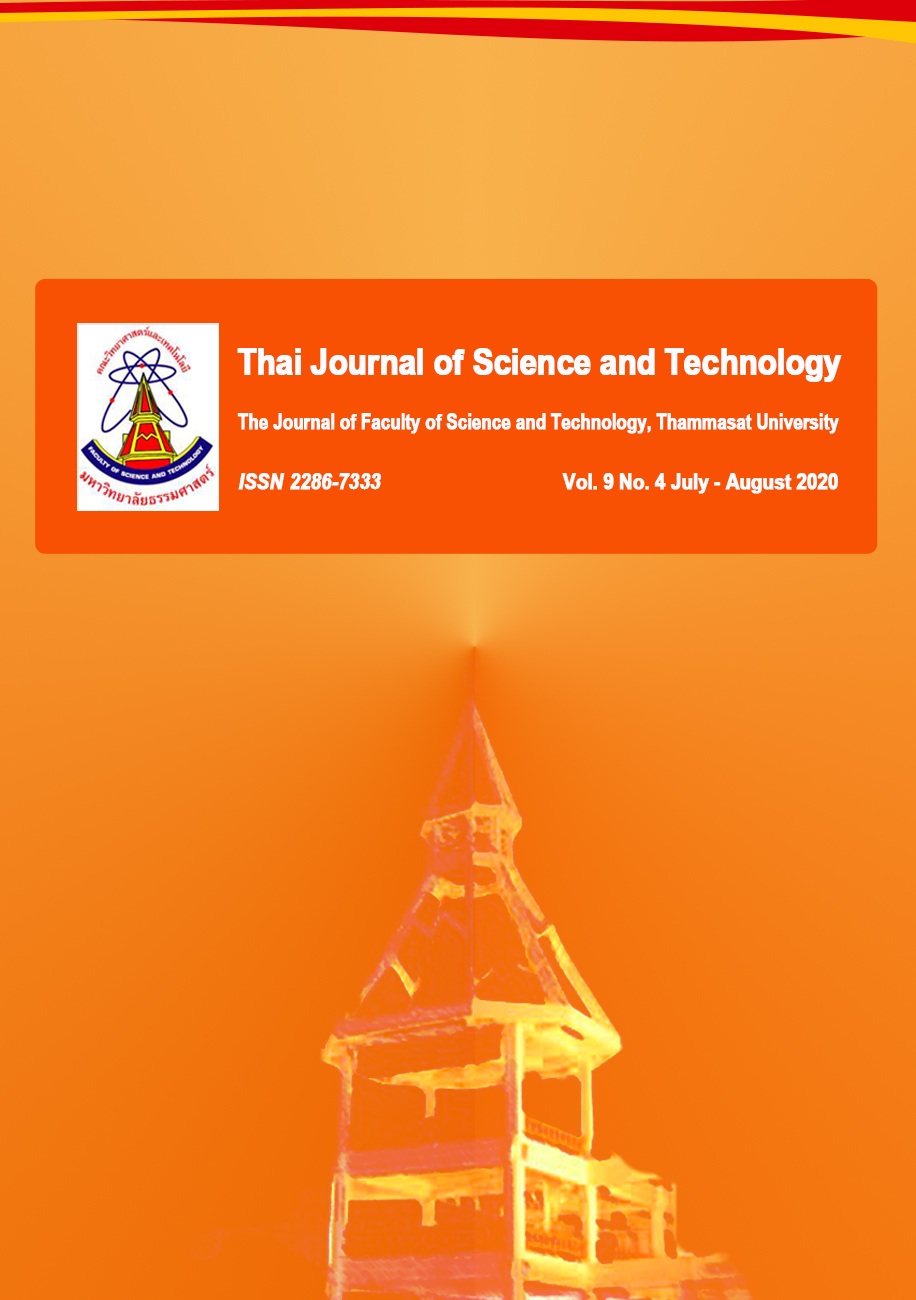กายวิภาคศาสตร์เปรียบเทียบก้านใบย่อยของไม้ต้น 6 ชนิด ในสกุล Dalbergia (Fabaceae)
Main Article Content
Abstract
Many tree species in the genus Dalbergia are valuable woods and used as a source of luxury furniture and flooring. However, some species have very similar morphological characteristics. In this case, the floral parts are the key trait for identification of those species. However, flowering time of the year can be problematic due to not present flowers all year round. Petiolule, on the other hand, is more practical in terms of specimen collection. The objective of this research was to study the anatomical petiolule structures in 6 Dalbergia tree species distributed in northeastern Thailand, including Dalbergia glomeriflora, D. cultrata, D. lanceolaria var. lakhonensis, D. nigrescens, D. oliveri and D. Cochinchinensis, to make a key identification. The results showed that some differences among all species were found in the presence or absence of trichomes, brown or red ergastic substances in cortical cells, vascular bundle shape and cuticle thickness. Based on these characteristics, an identification key of chosen Dalbergia species was made. In addition, there were no differences in anatomical characteristics in each position of petiolule (proximal, medial and distal). Therefore, the identification key of petiolule characters is one of suitable tools to enhance the taxonomy of this genus.
Article Details
บทความที่ได้รับการตีพิมพ์เป็นลิขสิทธิ์ของคณะวิทยาศาสตร์และเทคโนโลยี มหาวิทยาลัยธรรมศาสตร์ ข้อความที่ปรากฏในแต่ละเรื่องของวารสารเล่มนี้เป็นเพียงความเห็นส่วนตัวของผู้เขียน ไม่มีความเกี่ยวข้องกับคณะวิทยาศาสตร์และเทคโนโลยี หรือคณาจารย์ท่านอื่นในมหาวิทยาลัยธรรมศาสตร์ ผู้เขียนต้องยืนยันว่าความรับผิดชอบต่อทุกข้อความที่นำเสนอไว้ในบทความของตน หากมีข้อผิดพลาดหรือความไม่ถูกต้องใด ๆ
References
เบญจวรรณ ชิวปรีชา, 2558, กายวิภาคและสมบัติของเนื้อไม้วงศ์ถั่วบางชนิด, วิทยานิพนธ์ปริญญาเอก, มหาวิทยาลัยเกษตรศาสตร์, กรุงเทพฯ.
เบญจวรรณ ชิวปรีชา, ฉัตรชัย เงินแสงสรวย และประศาสตร์ เกื้อมณี, 2559, กายวิภาคเปรียบเทียบเนื้อไม้พื้นเมืองวงศ์ถั่ว 6 ชนิด ในประเทศไทย, ว.วนศาสตร์ 35(2): 32-40.
ประศาสตร์ เกื้อมณี, 2551, เทคนิคเนื้อเยื่อพืช, สำนักพิมพ์มหาวิทยาลัยเกษตรศาสตร์, กรุงเทพฯ.
สราวุธ สังข์แก้ว, 2562, รุกขวิทยาภาคสนาม, น. 334-345, ใน สราวุธ สังข์แก้ว และอัจฉรา ตีระวัฒนานนท์ (บรรณาธิการ), รุกขวิทยาภาคสนาม (Field Dendrology), มหาวิทยาลัยเกษตรศาสตร์, กรุงเทพฯ.
Agbaywa, I.O. and Noukwu, B.C., 2004, The value of morpho-anatomical features in the systematic of Cucurbita species in Nigeria, Afr. J. Biotechnol. 3: 541-546.
Bhadane, V.V., 2006, Taxonomic significance of the structure of the rachis, petiole and petiolule in Meliaceae, Bioinfolet 3: 234-239.
Ennos, A.I., Spatz, H.Ch. and Speck, T.T., 2000, The function morphology of the petiole of the banana, Musa tectilis, J. Exp. Bot. 51: 2085-2093.
Gasson, P., Miller, R., Stekel, D.J., Whinder, F. and Ziemińska, K., 2010, Wood identification of Dalbergia nigra (CITES Appendix I) using quantitative wood anatomy, principal components analysis and naïve Bayes classification, Ann. Bot. 105: 45-56.
Heneidak, S. and Shaheen, A.S.M., 2007, Characteristics of the proximal to distal regions of the petioles to identify 15 tree species of Papilionoideae-Fabaceae, Bangladesh J. Plant Taxon.14: 101-115.
Johansen, D.A., 1940, Plant Microtechique, McGraw-Hill Book Company, Inc., London.
Rashida, G.J.N., Venkatarathnakumar, T., Atitha Dhas Aruna, Gowri, R., Parameshwari, R., Shanthi, M. and Raadhika, K., 2012, Pharmacognostic and Preliminary phytochemical evaluation of the leaves of Dalbergia sissoo Roxb., Asian J. Pharm. Clin. Res. 5: 115-119.
Klitgaard, B.B. and Lavin, M., 2005, Tribe Dalbergieae, pp., 307-335, In Lewis, G.P., Schrire, B.D., Lock, M. and Mackinder, B., Legumes of the World, Royal Botanic Gardens, Kew.
Maria, B.G. and Rodriigo, O., 2003, Leaf anatomy of rubber tree clones, Sci. Agric. 60: 709-713.
Neves, M.V.M.D., Araújo, N.D., Oliveira, E.D.J. and Agra, M.D.F., 2016, Leaf and stem anatomy and histochemistry of Dalbergia ecastaphyllum, Pharm. J. 8: 557-564.
Neves, M.V.M.D., Araújo, N.D., Oliveira, E.D.J. and Agra, M.D.F., 2016, Leaf and stem anatomy and histochemistry of Dalbergia ecastaphyllum, Pharm. J. 8: 557-564.
Niyomdham, C., 2002, An account of Dalbergia (Leguminosae-Papilionoideae) in Thailand, Thai For. Bull (Bot.) 30: 124-166.
Niyomdham, C., 2018, Dalbergia, pp. 286-325, In Balslev, H. and Chantaranothai, P. (Eds.), Leguminosae-Papilionoideae, Flora of Thailand Volume 4 Part 3.13, Prachachon Co., Ltd., Bangkok.
Osuoha, V.U.N., Mbagwu, F.N., Inyama, C.N. and Ukpai, K.U., 2015, Systematic characterization of six Citrus species using petiole anatomy, Medicinal & Aromatic Plants S1: 005. Doi: 10.4172/2167-0412.S1-005.
Pardi, M., Hussin, K. and Latiff, A., 1991, Anatomi petiol beberapa spesies daripada family Dipterocarpaceae Malaysia, Prioriti Penyelidikan IRPA 1991: 610-617.
Rabinarayan, A., Switu, J., Harisha, C.R. and Vinay, S., 2018, Pharmacognostical genetic barcoding and phytochemical analysis on leaves of Dalbergia volubilis Roxb. – an extra pharmacopoeial drug of Ayurveda, Int. J. Pharm. Pharm. Sci. 10: 117-124.
Ravaomanalina, B.H., Crivellaro, A. and Schweingruber, F.H., 2017, Dalbergia, pp. 13-51. In Ravaomanalina, B.H., Crivellaro, A., and Schweingruber, F.H. (Eds.), Stem Anatomy of Dalbergia and Diospyros Species from Madagascar, Springer, Cham.
Ruzi, A.R., Hussin, K. and Noraini, T., 2009, Systematic significance of the petiole vascular bundles types in Dipterocarpus Gaertn.F. (Dipterocarpaceae), Malaysian Appl. Biol. 38: 11-16.
Saquaro, A., 2005, Leaf morphology and anatomy of the Ficus plant, Afr. J. Biotechnol. 5: 331-
Shaheen, A.M., 2006, The value of vascular supply of the petiole trace characteristics in the systematic of some species of subfamily: Mimosoideae-Leguminosae, Assuit Univ. J. Bot. 35: 193-213.
Stuessy, F.T., 1990, Plant Taxonomy, pp. 514, The Systematic Evolution of Comparative Data, Columbia University Press, New York.
Talip, N., Cutler, D.F., Puad, A.S.A., Ismail, B.S., Ruzi, A.R. and Ahmad Juhari, A.A., 2017, Diagnostic and systematic significance of petiole anatomy in the identification of Hopea species (Dipterocarpaceae), South Afr. J. Bot. 111: 111-125.

